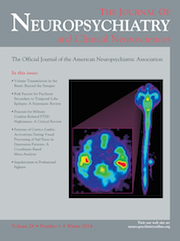Improvement in Psychotic Symptoms and Social Functioning After Augmentation of Paliperidone With Clozapine in a Patient With Schizoaffective Disorder
To the Editor: “Mrs. B,” who had significant depression symptoms and psychotic symptoms with significant exacerbations of self-care in the past 7 months, was diagnosed with schizoaffective disorder, depressed subtype, because of persistent psychotic symptoms even after response of her depression with mirtazapine 60 mg/day. She still had significant psychotic symptoms even after several kinds of antipsychotics, such as risperidone 8 mg/day, olanzapine 30 mg/day, and aripiprazole 30 mg/day during her 1-month hospitalization (Brief Psychiatric Rating Scale−18 items [BPRS−18] scores: 56, especially in items of uncooperativeness [6 points], hallucinatory behaviors [7 points], hostility [6 points] and suspiciousness [6 points]). Because of apparent treatment-resistance, the antipsychotic was switched to clozapine 200 mg/day gradually, with excessive salivation side effects. The responses of her psychotic symptoms still remained limited after using clozapine (BPRS−18 scores: 53). Her self-care, social, and occupational functioning also did not improve (Social and Occupational Function Assessment Scale [SOFA] score: 20].
Because of the persistence of psychotic symptoms even under clozapine, we added paliperidone 9 mg/day to assist the control of psychotic symptoms. She had significant improvement of psychotic symptoms (BPRS scores: 53 > 38; items of uncooperativeness [6 > 2], hallucinatory behaviors [7 > 3], hostility [6 > 3] and suspiciousness [6 > 3]) after augmentation of paliperidone for 1 month. No significant side effects after combinations of clozapine and paliperidone were observed. After discharge, she could go to market to buy commodities and had better ability for self-care. Her social functioning also showed significant improvement (SOFA score: 20 > 55).
Discussion
This patient had significant improvements of treatment-resistant psychotic symptoms after augmentation of paliperidone with clozapine. It might be related to the serotonin 5-HT2A antagonism and dopamine D2 antagonism effects of paliperidone. Besides, paliperidone is effective in the treatment of schizoaffective disorder.1 Paliperidone has been reported to improve personal and social functioning in schizophrenia patients.2 Paliperidone also has a better profile of side effects and less harm.3 Healthy volunteers using paliperidone had better performance on Stroop Word–Color tests than on risperidone or placebo. This suggests that paliperidone might improve cognitive functioning.4 Kim et al.’s report on schizophrenia patients also supports the role of paliperidone in the improvement of neurocognitive and social functioning.5 In this patient, I hypothesized that paliperidone augmentation might enhance the clozapine’s 5HT2A antagonism with better results in social and occupational functions. Also, paliperidone might enhance D2 antagonism effects of clozapine because of paliperidone’s higher affinity for D2 receptors, which will decrease psychotic symptoms.6 To my knowledge, this is first case report about clozapine and paliperidone combination therapy in schizoaffective disorder. This combination might be an alternative for treatment-resistant schizoaffective patients.
1 : Oral paliperidone: a review of its use in the management of schizoaffective disorder. CNS Drugs 2011; 25:523–538Crossref, Medline, Google Scholar
2 : Effects of paliperidone extended release on the symptoms and functioning of schizophrenia. BMC Clin Pharmacol 2012; 12:1Crossref, Medline, Google Scholar
3 : Number needed to treat and number needed to harm with paliperidone palmitate relative to long-acting haloperidol, bromperidol, and fluphenazine decanoate for treatment of patients with schizophrenia. Neuropsychiatr Dis Treat 2011; 7:93–101Crossref, Medline, Google Scholar
4 : Different safety profiles of risperidone and paliperidone extended-release: a double-blind, placebo-controlled trial with healthy volunteers. Hum Psychopharmacol 2012; 27:305–314Crossref, Medline, Google Scholar
5 : Paliperidone ER versus risperidone for neurocognitive function in patients with schizophrenia: a randomized, open-label, controlled trial. Int Clin Psychopharmacol 2012; 27:267–274Crossref, Medline, Google Scholar
6 : Upcoming agents for the treatment of schizophrenia: mechanism of action, efficacy, and tolerability. Drugs 2008; 68:2269–2292Crossref, Medline, Google Scholar



